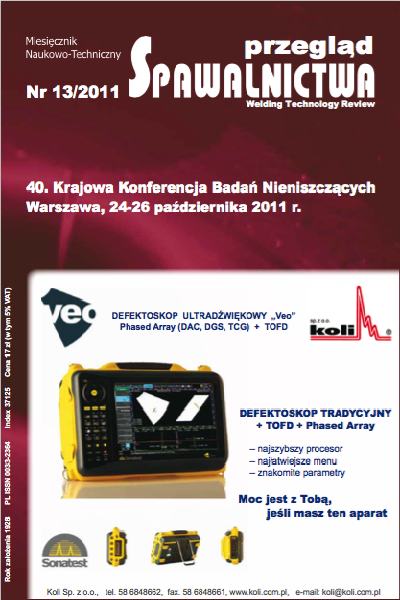Wpływ naprężeń czynnych i resztkowych na własne pole magnetyczne ferromagnetyków
Main Article Content
Abstract
Wpływ naprężeń na zmiany namagnesowania jest jednym z najbardziej złożonych zagadnień magnetyzmu. W artykule analizowano wpływ naprężeń czynnych i resztkowych na zmiany własnego magnetycznego pola rozproszenia WMPR mierzonego na powierzchni elementu oraz możliwości wykorzystania tych zmian jako sygnału diagnostycznego pozwalającego na określenie stanu naprężeń. Stwierdzono wpływ zarówno naprężeń czynnych jak i resztkowych na rozkład składowych WMPR. Wykorzystanie pomiarów WMPR do oceny naprężeń czynnych na obecnym etapie badań wydaje się problematyczne. Ocena makroskopowych naprężeń resztkowych na podstawie pomiarów WMPR jest zagadnieniem nad którym kontynuowane są prace badawcze.
The impact of active and residual stress on the residual magnetic field of ferromagnetics
Abstract
The impact of stress on changes in magnetisation is one of the most complex issues of magnetism. The paper presents an analysis of the impact of active and residual stress on the changes in the residual magnetic field (RMF) measured on the surface of the component, and of the possibility of using the changes as a diagnostic signal which allows the determination of the stress state. It was found that both active and residual stress had an impact on the distribution of the RMF components. The use of the RMF measurements to assess active stress seems debatable at the present stage of research development. Research work now continues on the assessment of macroscopic residual stress based on the RMF measurements.
Downloads
Article Details
Creative Commons CC BY 4.0 https://creativecommons.org/licenses/by/4.0/
Welding Technology Review (WTR) articles are published open access under a CC BY licence (Creative Commons Attribution 4.0 International licence). The CC BY licence is the most open licence available and considered the industry 'gold standard' for open access; it is also preferred by many funders. This licence allows readers to copy and redistribute the material in any medium or format, and to alter, transform, or build upon the material, including for commercial use, providing the original author is credited.
References
Mierczak L., Jiles D. C., IEEE TRANS G.: ON MAGN., Vol. 47, [7] nr. 2/2011 s. 459-65.
Tomohiro Yamasaki i inni, NDT&E International, Vol. 29, No. [8] 5/ 1996 s. 263-268.
Kaminski D.A. i inni: J. of Magnetism and Magnetic Materials 104-107, 1992, 382 384
Lu Li, David C. Jiles IEEE TRANS. ON MAGNETICS, Vol. 39, nr. 5, 09 2003 3037.
D. C. Jiles, J. Phys. D, Appl. Phys., vol. 28, s. 1537, 1995.
K. Kashiwaya, Jpn. J. Appl. Phys., vol. 30, s. 2932, 1991.
C. S. Schneider, J. M. Richardson, J. Appl. Phys., vol. 53, s. 8136, 1982.
M.J. Sablik i inni Journal of Magnetism and Magnetic Materials 132 1994, s. 131-148.
J. Pearson i inni IEEE TRANS. ON MAGNETICS, VOL. 36, nr. 5, 09 2000, s. 3251-3.
Laurent Daniel, Olivier Hubert IEEE TRANS. ON MAGNE- TICS, Vol. 46, nr. 8, AUGUST 2010 s. 3089-92.
Daniel Peter Bulte IEEE TRANS. ON MAGNETICS, Vol. 45,
nr. 1, 01 2009 83.
M. Roskosz, M. Bieniek, NDT&E International, doi:10.1016/j.
ndteint.2011.09.007.
